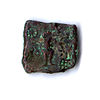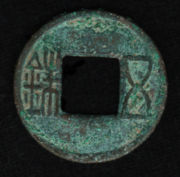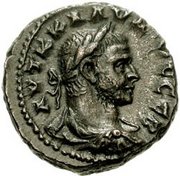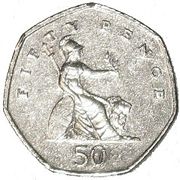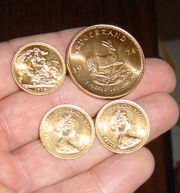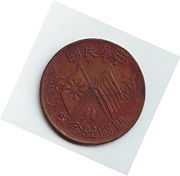Coin
2008/9 Schools Wikipedia Selection. Related subjects: Currency
 |
| Numismatics Terminology |
Currency
Circulating currencies
Fictional currencies |
Ancient currencies
Medieval currencies
|
Production
|
Exonumia
Notaphily Scripophily
|
A coin is usually a piece of hard material, usually metal or a metallic material, usually in the shape of a disc, and most often issued by a government. Coins are used as a form of money in transactions of various kinds, from the everyday circulation coins to the storage of vast numbers of bullion coins. In the present day, coins and banknotes make up the cash forms of all modern money systems. Coins made for circulation (general monetized use) are usually used for lower-valued units, and banknotes for the higher values; also, in most money systems, the highest value coin is worth less than the lowest-value note. The face value of circulation coins is usually higher than the gross value of the metal used in making them, but this is not generally the case with historical circulation coins made of precious metals. For example, the historical Eagle contained .48375 troy ounce of gold and has a face value of only ten U.S. dollars, but the market value of the coin, due to its metal content, is now many times the face amount.
Exceptions to the rule of coin face-value being higher than content value, also occur for some non- monetized " bullion coins" made of silver or gold (and, rarely, other metals, such as platinum or palladium), intended for collectors or investors in precious metals. For examples of modern gold collector/investor coins, the United States mints the American Gold Eagle, Canada mints the Canadian Gold Maple Leaf, and South Africa mints the Krugerrand. The American Gold Eagle has a face value of US$50, and the Canadian Gold Maple Leaf coins also have nominal (purely symbolic) face values (e.g., C$50 for 1 oz.); but the Krugerrand does not.
Historically, a great number of coinage metals (including alloys) and other materials have been used practically, impractically (i.e., rarely), artistically, and experimentally in the production of coins for circulation, collection, and metal investment, where bullion coins often serve as more convenient stores of assured metal quantity and purity than other bullion.
Coins have long been linked to the concept of money, as reflected by the fact that in other languages the words "coin" and "currency" are synonymous. Fictional currencies may also bear the name coin (as such, an item may be said to be worth 123 coin or 123 coins).
Collecting coins
See Coin collecting and Numismatics for more information on the collecting of coins, bank notes, token coins and exonumia. Also see mint mark.
The value of a coin
In terms of its value as a collector's item, a coin is generally made more or less valuable by its condition, specific historical significance, rarity, quality/beauty of the design and general popularity with collectors. If a coin is greatly lacking in any of these, it is unlikely to be worth much. Bullion coins are also valued based on these factors, but are largely valued based on the value of the gold or silver in them. Sometimes non-monetized bullion coins such as the Canadian Maple Leaf and the American Gold Eagle are minted with nominal face values less than the value of the metal in them, but as such coins are never intended for circulation, these value numbers are not market nor fiat values, and are never more than symbolic numbers.
Most coins presently are made of a base metal, and their value comes from their status as fiat money. This means that the value of the coin is decreed by government fiat (law), and thus is determined by the free market only as national currencies are subjected to arbitrage in international trade. This causes such coins to be monetary tokens in the same sense that paper currency is, when the paper currency is not backed directly by metal, but rather by a government guarantee of international exchange of goods or services. Some have suggested that such coins not be considered to be "true coins" (see below). However, because fiat money is backed by government guarantee of a certain amount of goods and services, where the value of this is in turn determined by free market currency exchange rates, similar to the case for the international market exchange values which determines the value of metals which back commodity money, in practice there is very little economic difference between the two types of money (types of currencies).
Coins may be minted that have fiat values lower than the value of their component metals, but this is never done intentionally and initially for circulation coins, and happens only in due course later in the history of coin production due to inflation, as market values for the metal overtake the fiat declared face value of the coin. Examples of this phenomenon include the pre-1965 US dime, quarter, half dollar, and dollar, US nickel, and pre-1982 US penny. As a result of the increase in the value of copper, the United States greatly reduced the amount of copper in each penny. Since mid-1982, United States pennies are made of 97.5% zinc coated with 2.5% copper. Extreme differences between fiat values and metal values of coins causes coins to be removed from circulation by illicit smelters interested in the value of their metal content. In fact, the United States Mint, in anticipation of this practice, implemented new interim rules on December 14, 2006, subject to public comment for 30 days, which criminalize the melting and export of pennies and nickels. Violators can be punished with a fine of up to $10,000 and/or imprisoned for a maximum of five years.
To distinguish between these two types of coins, as well as from other forms of tokens which have been used as money, some monetary scholars have attempted to define three criteria that an object must meet to be a "true coin". These criteria are:
- It must be made of a valuable material, and trade for close to the market value of that material.
- It must be of a standardized weight and purity.
- It must be marked to identify the authority that guarantees the content
First coins
The question of the world's first coin has long been and still is debated. Among numismatists, it is debated whether the world's first coins originated in Lydia, China, or India (where coins were known as karshapana). One early coin from Caria, Asia Minor, includes a legend "I am the badge of Phanes," though most of the early Lydian pieces have no writing on them, just symbolic animals. Therefore the dating of these coins relies primarily on archeological evidence, with the most commonly cited evidence coming from excavations at the Temple of Artemis at Ephesos, also called the Ephesian Artemision (which would later evolve into one of the Seven Wonders of the ancient world). Many early Lydian coins were undoubtedly struck (manufactured) under the authority of private individuals and are thus more akin to tokens than true coins, though because of their numbers it's evident that some were official state issues, with King Alyattes of Lydia being the most frequently mentioned originator of coinage.
The first Indian coins were minted around the 6th century BC by the Mahajanapadas of the Indo-Gangetic Plain. The coins of this period were punch marked coins called Puranas, Karshapanas or Pana. The Mahajanapadas that minted their own coins included Gandhara, Kuntala, Kuru, Panchala, Shakya, Surasena, and Surashtra. Some argue that Indian coins were developed from Western prototypes, which the Indians came in contact with through Babylonian traders.
The first European coin to use Arabic numerals to date the year minted was the Swiss 1424 St. Gallen silver Plappart.
Coin debasement
Throughout history, governments have been known to create more coinage than their supply of precious metals would allow. By replacing some fraction of a coin's precious metal content with a base metal (often copper or nickel), the intrinsic value of each individual coin was reduced (thereby "debasing" their money), allowing the coining authority to produce more coins than would otherwise be possible. Debasement sometimes occurs in order to make the coin harder and therefore less likely to be worn down as quickly. Debasement of money almost always leads to price inflation unless price controls are also instituted by the governing authority, in which case a black market will often arise.
The United States is unusual in that it has only slightly modified its coinage system (except for the images and symbols on the coins, which have changed a number of times) to accommodate two centuries of inflation. The one-cent coin has changed little since 1856 (though its composition was changed in 1982 to remove virtually all copper from the coin) and still remains in circulation, despite a greatly reduced purchasing power. On the other end of the spectrum, the largest coin in common circulation is 25 cents, a low value for the largest denomination coin compared to other countries. Recent increases in the prices of copper, nickel, and zinc, mean that both the US one- and five-cent coins are now worth more for their raw metal content than their face (fiat) value. In particular, copper one-cent pieces (those dated prior to 1982 and some 1982-dated coins) now contain about two cents worth of copper. Some denominations of circulating coins that were formerly minted in the United States are no longer made. These include coins with a face value of half a cent, two cents, three cents, twenty cents, two dollars and fifty cents, three dollars, five dollars, ten dollars, and twenty dollars. In addition, cents were originally slightly larger than the modern quarter and weighed nearly half an ounce, while five cent coins were smaller than a dime and made of a silver alloy. Dollars were also much larger and weighed approximately an ounce. Half dollar and one dollar coins are still produced but rarely used. The U.S. also has bullion and commemorative coins with the following denominations: 50¢, $1, $5, $10, $25, $50, and $100.
Features of modern coinage
The milled, or reeded, edges still found on many coins (always those that were once made of gold or silver, even if not so now) were originally designed to show that none of the valuable metal had been shaved off the coin. Prior to the use of milled edges, circulating coins commonly suffered from "shaving", by which unscrupulous persons would shave a small amount of precious metal from the edge. Unmilled British sterling silver coins were known to be shaved to almost half of their minted weight. This form of debasement in Tudor England was commented on by Sir Thomas Gresham, whose name was later attached to Gresham's Law. The monarch would have to periodically recall circulating coins, paying only bullion value of the silver, and reminting them.
Traditionally, the side of a coin carrying a bust of a monarch or other authority, or a national emblem, is called the obverse, or colloquially, heads. The other side is called the reverse, or colloquially, tails. However, the rule is violated in some cases. Another rule is that the side carrying the year of minting is the obverse, although some Chinese coins, most Canadian coins, the British 20p coin, and all Japanese coins, are an exception.
The orientation of the obverse with respect to the reverse differs between countries. Some coins have coin orientation, where the coin must be flipped vertically to see the other side; other coins, such as British coins, have medallic orientation, where the coin must be flipped horizontally to see the other side.
The exergue is the space on a coin beneath the main design, often used to show the coin's date, although it is sometimes left blank or containing a mint mark, privy mark, or some other decorative or informative design feature. Many coins do not have an exergue at all, especially those with few or no legends, such as the Victorian bun penny.
Coins that are not round (British 50 pence for example) usually have an odd number of sides, with the edges rounded off. This is so that the coin has a constant diameter, and will therefore be recognised by vending machines whichever way it is inserted. Alternatively some older designs still in circulation have a large number of sides which reduce the difference in width, such as the Australian 50 cent coin with twelve flat sides. The triangular coin (produced to commemorate the 2007/2008 Tutankhamun exhibition at the The O2 Arena) was commissioned by the Isle of Man, became legal tender on 6 December 2007 and has a value of 25p (a crown). The triangular coin issued to commemorate the return of Tutankhamun treasures to London was not the first coin with a triangular shape. Some triangular coins produced earlier include : Cabinda coin, Bermuda coin, 2 Dollar Cook Islands 1992 triangular coin, Uganda Millennium Coin and Polish Sterling-Silver 10-Zloty Coin.
Coins are popularly used as a sort of two-sided die; in order to choose between two options with a random possibility, one choice will be labeled "heads" and the other "tails," and a coin will be flipped or "tossed" to see whether the heads or tails side comes up on top. See Bernoulli trial; a fair coin is defined to have the probability of heads (in the parlance of Bernoulli trials, a "success") of exactly 0.5. A widely publicized example of an asymmetrical coin which will not produce "fair" results in a flip is the Belgian one euro coin. See also coin flipping. Coins are sometimes falsified to make one side weigh more, in order to simulate a fair type of coin which is actually not fair. Such a coin is said to be "weighted."
Some coins, called bracteates, are so thin they can only be struck on one side.
Bi-metallic coins are sometimes used for higher values and for commemorative purposes. In the 1990s, France used a tri-metallic coin. Common circulating examples include the €1, €2, British £2 and Canadian $2.
Guitar-shaped coins were once issued in Somalia, Poland once issued a fan-shaped 10 złoty coin, but perhaps the oddest coin ever was the 2002 $10 coin from Nauru, a Europe-shaped coin.
The Royal Canadian Mint is now able to produce holographic-effect gold and silver coinage.
For a list of many pure metallic elements and their alloys which have used in actual circulation coins and for trial experiments, see coinage metals.
